13.2 Introduction to the Neurological System
Anatomy and Physiology
The brain is made up of billions of nerve cells, called neurons (see Figure 13.1), that communicate with even more connections, called synapses (see Figure 13.2). At the synapses, there are chemical and electrical reactions that maintain brain health. This process is called synaptic stability, and disruptions to neuron communication may lead to many psychiatric and neurological diseases.
Read more: Synapse Pathology in Psychiatric and Neurologic Disease.
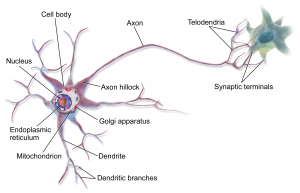
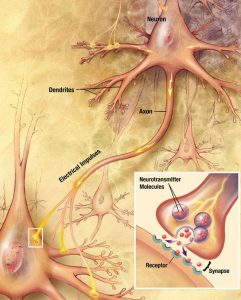
Clinical manifestations may be explained by dysfunction in anatomy and physiology. Therefore, understanding these concepts is essential.
The specialized areas of the brain (see Figure 13.3) include:
- The cortex is the outermost layer of the brain that is responsible for voluntary movements.
- The brain stem lies between the brain and the spinal cord and is responsible for breathing and sleep.
- The basal ganglia is inside the middle of the brain and is responsible for coordinating the “messages” between many different parts of the brain.
- The cerebellum is at the base of the brain and is responsible for coordination and balance.
The lobes of the brain (see Figure 13.4) include:
- “The frontal lobe is responsible for problem-solving and judgment and motor function.” (WebMD 2021)
- The parietal lobe is responsible for sensation, handwriting, and body position.
- The temporal lobe is responsible for memory and hearing.
- The occipital lobe is responsible for vision.
The brain is protected by the meninges and the skull.
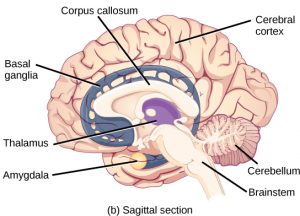
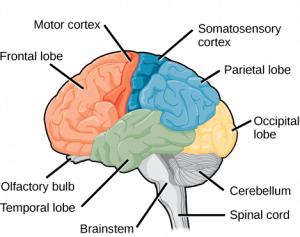
The neurological system is important to assess because it is responsible for relaying messages from all body systems to the brain and spinal cord, and from the brain and spinal cord back out to all body systems. It is involved in regulating:
- Senses (e.g., seeing, hearing, tasting, smelling, touching)
- Motor function (e.g., walking, balance, coordination)
- Cognition (e.g., level of consciousness, thinking)
As a nurse, your assessment of the neurological system provides information about the functioning of this system and potential cues that may require your action. This chapter focuses on the adult and adolescent (older child) population; neurological assessment of the newborn/infant/young child is beyond the scope of this chapter.
Neurological System Components
See Figures 13.5, 13.6, and 13.7 for the anatomy of the main components of the neurological system. The main components of the neurological system include:
The central nervous system:
- Brain
- Spinal cord
The peripheral nervous system:
- 12 paired cranial nerves
- 31 paired spinal nerves

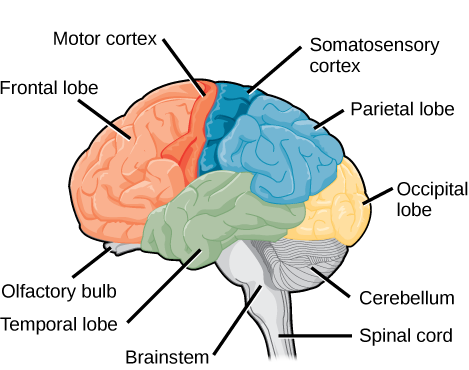

If you want to refresh your knowledge of anatomy and physiology of the nervous system, watch these videos on the nervous system, the central nervous system, and the peripheral nervous system.
Clinical Tip
The neurological system is closely interconnected with and influences all body systems, so it is rarely assessed in isolation. When attempting to make sense of neurological cues, nurses commonly assess related body systems. For example, hypertension (and the pathophysiological processes of atherosclerosis) is a major risk factor for stroke.
Citations and Attribution
Creative Commons brain image by OpenStax College: The Central Nervous System. OpenStax CNX. May 10, 2013 http://cnx.org/contents/24e8609c-16a7-4dd5-b3da-e38aaeef7ed5@4@4.Concepts of Biolog-1st Canadian Edition 16.3
The Central Nervous System, Figure of The human cerebral cortex includes the frontal, parietal, temporal, and occipital lobes. https://opentextbc.ca/biology/chapter/16-3-the-central-nervous-system/
Picture of the Brain, Human Anatomy by Matthew Hoffman, MD June 23, 2021, https://www.webmd.com/brain/picture-of-the-brain
The Neuron, Wikipedia The Free Encyclopedia, last edited 04:34 July 25, 2021, Retrieved 03:03 July 29, 2021, https://en.wikipedia.org/wiki/Neuronvan Spronsen, M., and Hoogenraad, C.,C.
Synapse Pathology in Psychiatric and Neurologic Disease. Curr Neurol Neurosci Rep. 2010; 10(3): 207–214, Retrieved 03:29 July 29, 2021 https://www.ncbi.nlm.nih.gov/pmc/articles/PMC2857788/

